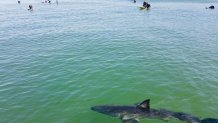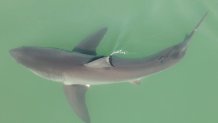A San Diego man is using his drone to capture images of several white sharks swimming along the coast in Del Mar. The videos and photographs give an aerial view of white sharks swimming alongside surfers. It appears in some instances the surfers are unaware of the large predator among them.
“It’s fun to find them, to see something that big, they’re big as a surfboard,” said Scott Fairchild.
With the help of his drone, Fairchild can appreciate the white sharks from a much different perspective. The videos and photographs also help scientists track shark behavior.
Get top local stories in San Diego delivered to you every morning. Sign up for NBC San Diego's News Headlines newsletter.
“Those are all juveniles based on their size and that’s pretty common this time of year. They like hanging out at our beaches and they’re probably there because it’s safe for them. There’s lots of food and the water is warm,” said Chris Lowe, Ph.D., Director of the Shark Lab at California State University Long Beach.
“A juvenile, which ranges from 4 ½ feet to 9 feet long is still a juvenile,” Lowe added.
Drone video shows that some surfers can see the white sharks from their board. In one video a young surfer paddles next to the shark in a very calm manner.

“It was nice to see how calm that father and son where you can see that moment, he wants to show his kid,” said Fairchild
Local
“Just the power of it, plus the harmony of it. I think everyone is so scared of the great whites and I get it, apex predators, but they’re not a problem,” Fairchild added.
White shark attacks along the San Diego County coast are still very rare. The juveniles swimming near Del Mar are staying away from larger predators, according to Lowe. The sharks are not looking for humans.
“The number one thing we find in their stomachs is string rays and we have a lot of stingrays along our coastline so there is a plentiful food source,” said Lowe.

More people are using drones these days and that leads to more sightings.
Lowe says California’s conservation efforts have also helped increase the white shark population. Commercial fisheries are managed better, and marine mammal populations have also improved, according to Lowe.
Lowe expects the juvenile sharks to remain in the area until late autumn.
“I think it’s far more dangerous driving to the beach. The bottom line is these sharks are out there in the water all the time. People are in the water all the time. I guarantee a white shark swam by them and they didn’t even know it,” said Lowe.
Lowe says when the water temperatures are consistently below 60 degrees, that is usually a cue for the juvenile white sharks to migrate south. Adult sharks occasionally cruise along our coast heading north to hunt for elephant seals, but adults usually don’t stay around southern California beaches for long, according to Lowe.



